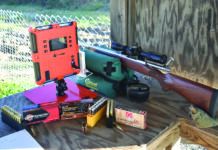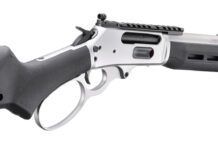Many people would agree that the AR platform is the most versatile of all rifle designs. Created for military combat (as many sporting rifles were originally), Eugene Stoner’s design can be long, short, scoped, topped with iron sights, and maintained by novice operators with just a short list of tools. Also, the design allows for a choice of cartridges, for it is the chambering that defines what it can effectively be used for. In this test, we pitted a gas-impingement-operated 308 Winchester AR-10 against a piston-operated 308 and a gas-impingement AR-10 chambered for what is becoming a popular standard cartridge, the 6.5 Creedmoor.
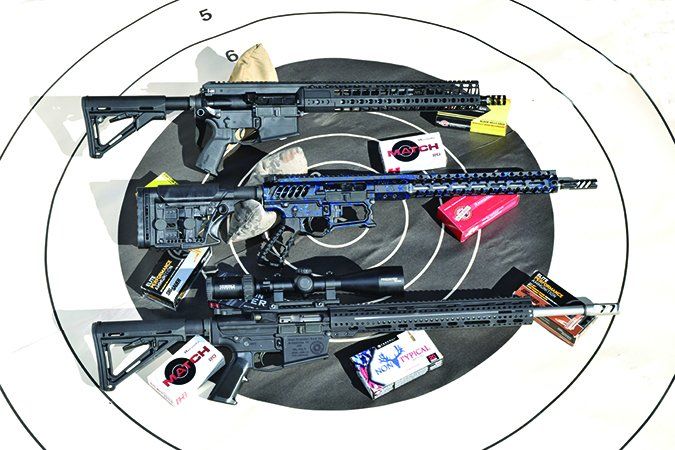
Our 308 Winchester AR-10s were the $3955 BDR10-3G Black/Blue Splash direct-impingement system and SIG Sauer’s $3108 716G2 DMR piston-driven system. A new rifle from the makers of E.R. Shaw Barrels, the E.R. Shaw ERS-10 chambered for 6.5 Creedmoor ammunition was a direct-impingement firearm carrying a list price of $995.
Range Data
| SIG Sauer 308 Winchester 150-gr. HT | SIG Sauer 716G2 DMR | F-1 Firearms BDR10-3G |
| Average velocity | 2622 fps | 2677 fps |
| Muzzle energy | 2289 ft.-lbs. | 2386 ft.-lbs. |
| Average group size | 1.1 in. | 1.3 in. |
| Black Hills 308 Winchester 155-gr. TMK | ||
| Average velocity | 2481 fps | 2481 fps |
| Muzzle energy | 2118 ft.-lbs. | 2118 ft.-lbs. |
| Average group size | 1.1 in. | 1.3 in. |
| SIG Sauer 308 Winchester 168-gr. OTM | ||
| Average velocity | 2479 fps | 2443 fps |
| Muzzle energy | 2292 ft.-lbs. | 2226 ft.-lbs. |
| Average group size | 0.7 in. | 0.7 in. |
| Black Hills 308 Winchester 175-gr. BTHP | ||
| Average velocity | 2473 fps | 2475 fps |
| Muzzle energy | 2376 ft.-lbs. | 2380 ft.-lbs. |
| Average group size | 0.8 in. | 0.9 in. |
| Federal 6.5 Creedmoor 140-gr. SP Non-Typical White Tail | E.R. Shaw ERS-10 | |
| Average velocity | 2571 fps | |
| Muzzle energy | 2054 ft.-lbs. | |
| Average group size | 0.6 in. | |
| Hornady 6.5 Creedmoor 140-gr. ELD Match 81500 | ||
| Average velocity | 2610 fps | |
| Muzzle energy | 2117 ft.-lbs. | |
| Average group size | 0.8 in. | |
| Hornady 6.5 Creedmoor 143-gr. ELD-X 81499 | ||
| Average velocity | 2583 fps | |
| Muzzle energy | 2118 ft.-lbs. | |
| Average group size | 0.7 in. | |
| Hornady 6.5 Creedmoor 147-gr. ELD Match 81501 | ||
| Average velocity | 2627 fps | |
| Muzzle energy | 2252 ft.-lbs. | |
| Average group size | 0.7 in. | |
| To collect accuracy data, we fired 5-shot groups from a sandbag rest. Distance: 100 yards. We recorded velocities using a CED chronograph, with the first sky screen set 12 feet from the muzzle. | ||
We chose four different rounds for collecting accuracy data from the 100-yard line at American Shooting Centers in Houston. The 308 rifles were fed SIG Sauer’s 150-grain HT and 168-grain Open-Tip Match (OTM) ammunition, and two rounds from Black Hills Ammunition. They were the 155-grain Sierra Tipped MatchKing (TMK) rounds and the 175-grain boat-tailed hollowpoints (BTHP). Our 6.5 Creedmoor selections for the E.R. Shaw rifle were Federal’s 140-grain soft-point “Non-Typical” White Tail rounds and three varieties from Hornady. They were the 140-grain Extremely Low Drag (ELD) Match, 143-grain ELD-X Precision Hunter, and the 147-grain ELD Match rounds. For optics we relied upon our Steiner 4-16x50mm Steiner Predator Xtreme first focal plane scope mounted inside a pair of 30mm Warne rings atop a riser from Yankee Hill Machine. Let’s find out which of our rifle trio was most accurate, reliable, and versatile:
F-1 Firearms BDR10-3G in Black w/ Blue Splash, 308 Winchester, $3955
GUN TESTS GRADE: B-
The custom BDR10-3G offered superb aesthetics and surprisingly good ergonomics. But we’d like more attention paid to basic assembly.

| ACTION TYPE | Gas-operated semi-auto, direct impingement; F-1 DuraBolt Classic bolt carrier |
| OVERALL LENGTH | 36.6 to 39.75 in. |
| OVERALL HEIGHT | 7.9 in. |
| BARREL | 16 in., 1:11 twist; stainless steel; CMB muzzle device |
| WEIGHT UNLOADED | 9 lbs. |
| WEIGHT LOADED | 9.4 lbs. |
| SIGHT RADIUS | N/A |
| LOWER RECEIVER | Anodized aluminum; blue splash finish; Picatinny top rail |
| MAGAZINE CAPACITY | 20 rds. |
| MAGAZINE TYPE | Detachable box, staggered column |
| BUTTSTOCK | 5-position telescoping Luth-AR MBA; adjustable comb and buttplate; glass-filled nylon buttplate |
| BUTTSTOCK LENGTH OF PULL | 12.5 to 16 in. |
| TRIGGER PULL WEIGHT | 2.8 lbs. Hiperfire single stage |
| SAFETY | 2-position rotating |
| WARRANTY | Lifetime, original owner |
| TELEPHONE | (832) 299-6100 |
| WEBSITE | F-1Firearms.com |
| MADE IN | USA |
We hadn’t really had an “OMG” moment at Gun Tests in 2018 as yet, but just as the new year was upon us, we opened the well-appointed custom gun case from F-1 Firearms. Inside was one of the most modern, well-appointed AR-10 rifles we’ve handled and also the best looking. Whereas the price of F-1’s Billet Full Build AR-10 rifle starts north of $2500, this was a variant beginning in the Special Edition Rifle menu. By “well appointed” we mean with features that are the latest in functional operation, beginning with the Luth-AR MBA buttstock, which was adjustable for length of pull, comb height, and the buttpad could be moved up or down as well as left and right. The bright-stainless-steel barrel was marked “1X11” for its twist rate and was a product of Black Hole Weaponry, made by Columbia River Arms of St. Helens, Oregon. Much of the remainder of the BDR10-3G was made in house at F-1’s Spring, Texas facility.

The BDR10’s 7075-T6 aluminum upper was sculpted so that the structure was narrow from side to side. The shell deflector was abbreviated, and the bolt carrier was visible through five diagonal reliefs on the right-hand side and four more on the left. Five windows were open on the left-hand side directly opposite the ejection port. The lower was even more interesting.
The flat sides of the lower were relieved so that the takedown pin protruded slightly, but the magazine release was behind a contour to protect it from unintentional discharge. The ambidextrous safety levers were fashioned as one arrow shape over another and relieved with small holes. The trigger guard was integral with the lower, and its enlarged elliptical shape displayed lightening holes cut into its lower arc. The Tactical Dynamics Skeletonized grip was bolted on using a large Allen-head fastener. Machined from aluminum, the grip featured three open sections on each side and three more between finger grooves up front. The grip was enhanced on its front and rear straps using paracord. A 20-round Magpul magazine was supplied.
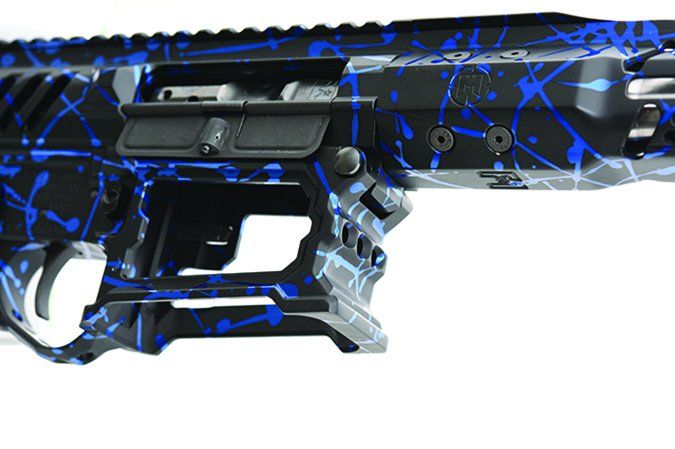
The mouth of the magazine well was funneled to act as a guide, but the sides of the well were cut away. Without a magazine in place, the workings of the magazine catch were visible. We wondered if the gun would be prone to stoppages because of debris entering through the reliefs or jamming the magazine release. We didn’t experience any stoppages, and one could say that anything that got into the mechanism would have just as much chance as being driven out the way it came in. Even with all the material removed for the sake of style if not faster handling, our F-1 rifle still weighed in just one ounce less than 9 pounds.
The 14.75-inch-long handguard was attached using eight relatively small Allen bolts shielding the chromed barrel and gas tube. The handguard was highly relieved with M-Lock rails along the bottom and sides. The top rail mimicked an M-Lock rail, but only the three forward most cutouts were wide enough to accept the M-Lock mounting pads. The upper, lower, and handguard can be purchased separately as the BDR chassis starting at $725. The F-1 Black Nitride CMB (compensating muzzle brake) consisted of different diameter holes and vents, leaving the bottom side intact to prevent dirt from being kicked up during firing.
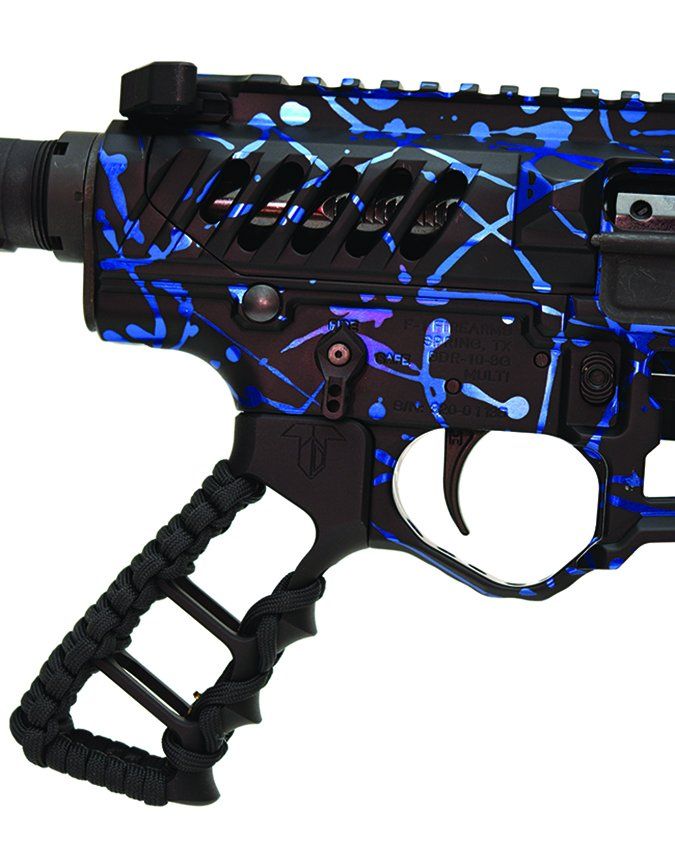
The HiperFire 24 3G single-action trigger was set at about 2.8 pounds with little or no perceptible take up or overtravel, contributing to its fast-cycling ability. The F-1 branded Raptor ambidextrous charging handle made bolt manipulation easier, but the choice of the Luth-AR MBA stock turned out to be unsuitable. When the stock was locked at either the first or second forward-most positions, the charging handle was blocked by the adjustable comb unless it was flat against the stock. The result was a minimum length of pull measuring about 14.6 inches instead of 12.5 inches, unless you were willing to do without raising the comb. It didn’t make sense to pay the upcharge of $180 for the Luth-AR buttstock if it would interfere with function.
Additional upcharges for special features included $115 for the skeletonized grip, $155 for the coated F-1 DuraBolt Classic bolt carrier, $145 for the Hiperfire trigger, and $300 for the Blue Splash finish. If any feature caused us to want to handle the F-1 rifle with kid gloves it was the finish. The pattern of shiny blue-over-black Type III Class 2 hard anodizing was a great custom look we were afraid would mar. But after the first day or so, we decided to treat the BDR10 like any other rifle that might see hard use. The finish proved highly abrasion resistant. With just a wipe down, the gun looked great after every session.
According to F-1, the company’s 308 Winchester rifles are tested primarily with 168-grain ammunition. Loaded with SIG Sauer’s 168-grain OTM (Open Tip Match) rounds, we printed groups measuring between 0.55 and just less than 0.8 inches across. On average, this was about 0.2 inches narrower than groups fired when loaded with the 175-grain boattail hollowpoint rounds from Black Hills Ammunition. The rifle showed a dislike of lighter bullets, indicated by groups measuring about 1.3 inches across firing both the SIG Sauer 150-grain HT rounds and the easy-shooting Black Hills 155-grain TMK ammunition.
There was a degree of slop between the lower and upper components, and by the end of sessions, the handguard was loose enough to wobble around, hitting the bottom of the gas block. We think that heat from the barrel played a part in loosening the handguard mounting screws. In fact heat waves rising through the skeletonized handguard were enough to distort our view of the target. We also noticed a marked loss of velocity as the barrel heated up. Velocity dropped in a straight line about 135 fps on average between the first and last shot of a string. This was about three times the loss of velocity than with the SIG and Shaw rifles.
Our Team Said: The adjustable comb got in the way of the charging handle, and we thought the buttpad was too hard. Otherwise, the aesthetics and ergonomics of the BDR10-3G were superb, which are two aspects that don’t always coincide. To fight mirage, we’d prefer a solid top rail to push the heat waves to either side. Most of all, we’d like to see better fit between the upper and lower and a stronger method of connecting the handguard. This particular model was not Mil-Spec, of course, but addressing these last two issues would likely unlock this rifle’s true potential, which in our view was considerable.
SIG Sauer 716G2 DMR 308 Winchester, $3108
GUN TESTS GRADE: A-
The softest-shooting AR-10 we’ve handled was also the loudest. This is a high-quality build that was easy to handle. Adding a suppressor would make this a dream rifle.

| ACTION TYPE | Semi-auto gas piston |
| OVERALL LENGTH | 34.75 to 38 in. |
| BARREL LENGTH/ TWIST | 16 in., 1:10 twist; carbon nitride-finished stainless steel |
| OVERALL HEIGHT | 8 in. |
| WEIGHT UNLOADED | 8.75 lbs. |
| WEIGHT LOADED | 10.25 lbs. |
| SIGHT RADIUS | N/A |
| ACTION | Aluminum alloy w/ carbon nitride finish; Picatinny top rail |
| MAGAZINE | 20 rds., detachable box, staggered column |
| BUTTSTOCK | 6-position adjustable/lockable; rubber buttplate |
| BUTTSTOCK LENGTH OF PULL | 11.5 to 15 in. |
| TRIGGER PULL WEIGHT | 2.75 lbs. |
| SAFETY | 2-position rotating |
| WARRANTY | Lifetime |
| TELEPHONE | (603) 310-3000 |
| WEBSITE | SIGsauer.com |
| MADE IN | USA |
The first lines beneath our test rifle found on the company website read “exceptional accuracy… further refined.” Since the other available 716G2 rifles were referred to as Patrol models, we think its safe to assume that DMR stands for Designated Marksman Rifle. A Designated Marksman is generally referred to as the member of a team or platoon tasked with longer-distance shots while maintaining the capability of laying down a high rate of fire.
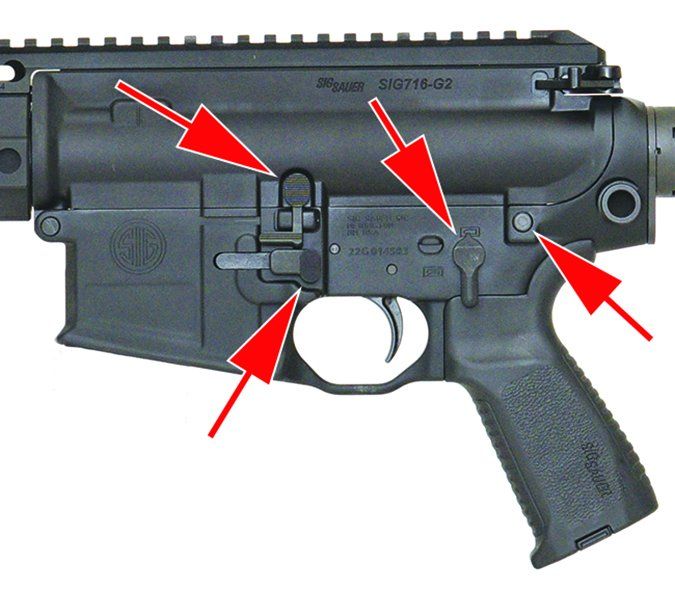
The first thing we noticed about the SIG Sauer 716G2 DMR was the tall handguard. The full-length Picatinny rail was raised more than 1.8 inches above the boreline to cover the operating rod. The valve that regulated gas to the piston was readily accessible through a window in the handguard that measured almost 1.5 inches long and 1 inch high. The 15-inch-long handguard covered the entire barrel save for the threads that were covered by the wide-open muzzle brake. With about 150 degrees of diameter machined from the sidewalls of its steel body, the brake was more a display of reflecting plates than we’re used to seeing.
In the owner’s manual, the handguard was referred to as the Rail Adapter Group #400. Consisting of a lower component that ends at the receiver, the upper half included a Picatinny top rail running continuously from muzzle to charging handle. This is a plus because there was no chance of misalignment should a scope be mounted forward of the upper receiver. The upper and lower parts of the Rail Adapter Group were secured by four bolts from the bottom side of the lower half. Plus, four more bolts just below the top rail at the receiver end each ran through the rear lug of the adapter group lower and into the rifle upper to secure the unit as one piece. There were Keymod inlets at 3, 6, and 9 o’clock. One last innovation on the handguard was that the key-locks on the sides offered a floor inside each inlet, making it easier to stabilize the mounting screws and keep them in place.
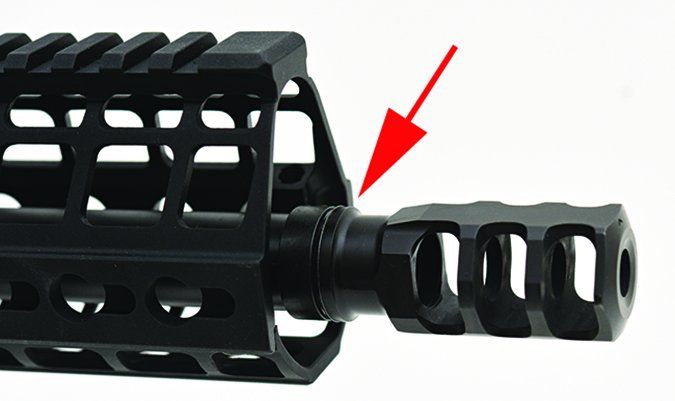
SIG Sauer has come up with its own style of machining small parts such as the bolt release, ambidextrous thumb safeties, and even an ambidextrous magazine release. The left-side magazine release pivots while the right-side release was a button that was pushed inward toward the center for the rifle. The charging handle was ambidextrous as well, with twin levers that released a claw hook from each side. The grip was a Magpul product with a SIG Sauer-style knurling on the side panels and a pinch-release cap on the bottom to create a storage area for tools, a small bottle of lubricant, or even ballast. There were holes on each side of the receiver meant for push-button quick-detach sling swivels. The buttstock, another Magpul product, offered another pair of connection points for QD swivels and slots for threading a sling. The buttstock was adjustable for six different lengths of pull, and it could be locked in place to eliminate movement. A 20-round Magpul magazine was supplied.
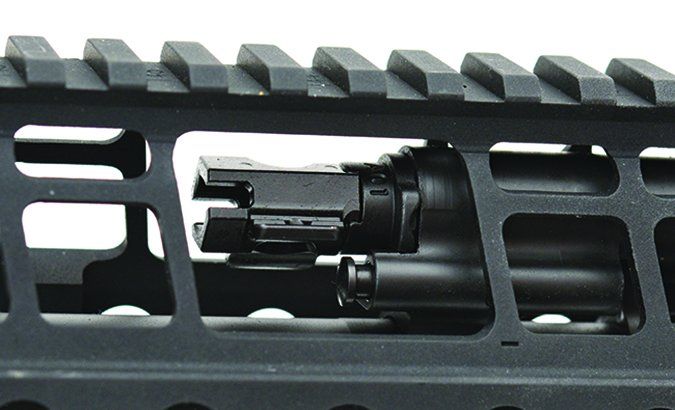
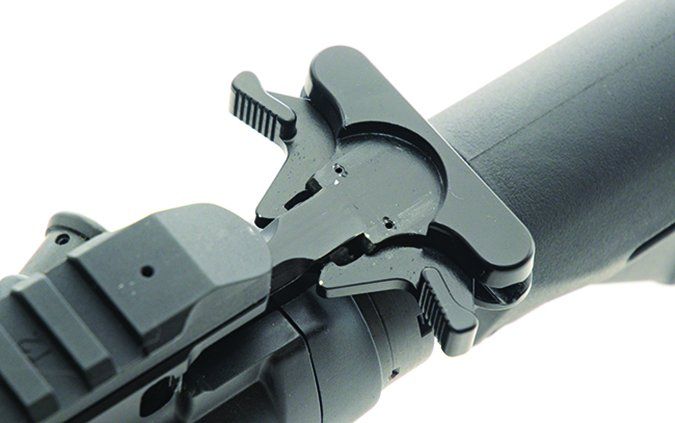
Through the ejection port we could see that material had been removed from the bolt carrier. Reduced mass reduces the shock of setting the bolt carrier in motion, but even more so when the bolt stopped and changed direction returning to battery. We found that the combination of the reduced bolt carrier, efficient muzzle brake, and the rifle’s 10+ pounds of weight when fully loaded made the 716G2 DMR one of the softest-shooting AR-10s we can remember. And this was not taking into account the readily available gas valve that enabled the rifle to be tuned to specific ammunition. Together with a precise trigger that began with brief take up leading to less than 3 pounds of resistance on average, we were able to shoot very pleasing groups. The SIG rifle could be depended upon to print five-shot groups measuring about 0.75 inches or less with both our 168-grain rounds from SIG Sauer and the 175-grain BTHP rounds from Black Hills ammunition. Our ammunition featuring lighter bullets printed groups just above the 1-minute-of-angle mark on average.
Our Team Said: The 716G2 DMR proved to be soft shooting and extremely consistent. It was well balanced in the hands, and the ambidextrous charging handle required very little effort to manipulate. The strength of its construction was evident to the hands as well as to the eyes. We doubt any amount of accessory weight such as lasers, lights, etc. would be enough to stress the handguard/Rail Adapter Group or to affect accuracy. The muzzle brake was very efficient, but also very loud, taking away some of the pleasure of shooting this rifle. In our view, with its short barrel and adjustable gas flow to the operating system, this rifle was meant to be shot suppressed. With a “can” in place, the 716G2 DMR might be a dream rifle.
E.R. Shaw ERS-10 6.5 Creedmoor, $995
GUN TESTS GRADE: A- (Best Buy)
There are a lot of guns out there, but few are what we would call bargains. This one stands out.

| ACTION TYPE | Semi-auto, direct impingement; nickel-boron-coated bolt and carrier |
| OVERALL LENGTH (min/max) | 38.75 to 41.7 |
| BARREL | 20 in., 1:8 twist; stainless steel, carbon-nitride finish; Shaw brake |
| OVERALL HEIGHT | 7.6 in. |
| WEIGHT UNLOADED | 9.4 lbs. |
| WEIGHT LOADED | 10.8 lbs. |
| SIGHT RADIUS | 16.14 in. |
| LOWER RECEIVER | Forged anodized aluminum; Picatinny top rail; A1 pistol grip; flared mag well; oversized trigger guard |
| MAGAZINE | Magpul 20-rd. detachable box; staggered column |
| BUTTSTOCK | Magpul 5-position adjustable; rubber buttplate |
| BUTTSTOCK LENGTH OF PULL | 11.7 to 14 in. |
| HANDGUARD | 15 in. free float M-Lock |
| TRIGGER PULL WEIGHT | 4.5 lbs., single stage |
| SAFETY | Rotating 2-position |
| WARRANTY | 1 year |
| TELEPHONE | (412) 221-3406 |
| WEBSITE | ERShawBarrels.com |
| MADE IN | USA |
E.R. Shaw of Pennsylvania has been making rifle barrels for more than 100 years, for both individuals and for famous makers. Chances are many of our readers own a rifle with an E.R. Shaw barrel, even if it was sold under another name. Best known for bolt-action rifles, they also make complete AR-15s and now AR-10 rifles that can be purchased as a set piece or from the “Rifle Builder” menu that appears on the website. Our ERS-10 was one of the maker’s first AR-10 production rifles. Chambered for 6.5 Creedmoor ammunition, we couldn’t believe our eyes when we read that the MSRP was just $995.
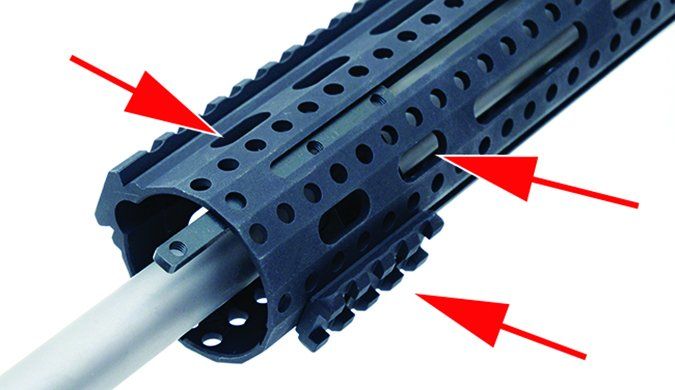
We could see where a little money was saved by attaching a standard A1 pistol grip, single-pull charging handle, standard magazine release, bolt catch/release lever, left-side-only safety lever, and the trigger was pretty much standard fare, breaking at about 4.5 pounds on average. But there were also a number of innovations that were apparent. The forged aluminum lower was expertly machined, including a flared Precision Wire EDM magazine well and oversized trigger guard. The bolt and bolt carrier were Nickel-Boron coated and the 20-inch-long stainless-steel barrel offered a glare-free satin stainless finish.

The muzzle brake of E.R. Shaw’s own design was stylish and effective without being too loud. The 15-inch-long free-float handguard was another example of some very solid machine work of original design firmly attached to the upper. The handguard offered a Picatinny rail on the top plane with M-Lock compatible slots found at 10, 2, 4, and 8 o’clock. E.R. Shaw supplies its own rail segments that thread into a track found on the interior of the rail at the traditional points of the compass, so there’s lots of optional positions to suit most shooters’ needs. The buttstock was a five-position adjustable unit by Magpul. A 20-round Magpul magazine was supplied.
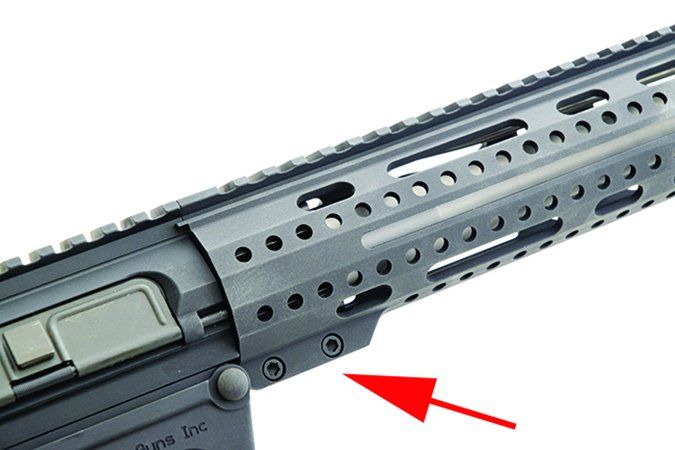
At the range, we found that even without a fancy trigger, custom grip, or locking buttstock, our ERS-10 could print five-shot groups of about 0.7 inches on average with every round we tried. Our best performer was the inexpensive 140-grain SP Non-Typical White Tail ammunition from Federal. Tied with many bolt-action rifles, the resulting average distance across our five-shot groups measured center to center computed to 0.60 inches. Averages for our other rounds were 0.8 inches, 0.7 inches, and 0.7 inches for Hornady’s 140-grain ELD Match, 143-grain ELD-X Precision Hunter, and 147-grain ELD Match, respectively.
Our Team Said: E.R. Shaw set out to offer an accurate and affordable AR-10 and did just that. This is a well-made rifle that showcases the quality of the company’s barrels when mounted properly within well-executed components. There aren’t many bargains in the world of firearms, but based on our experience with the ERS-10, this is certainly one that stands out.
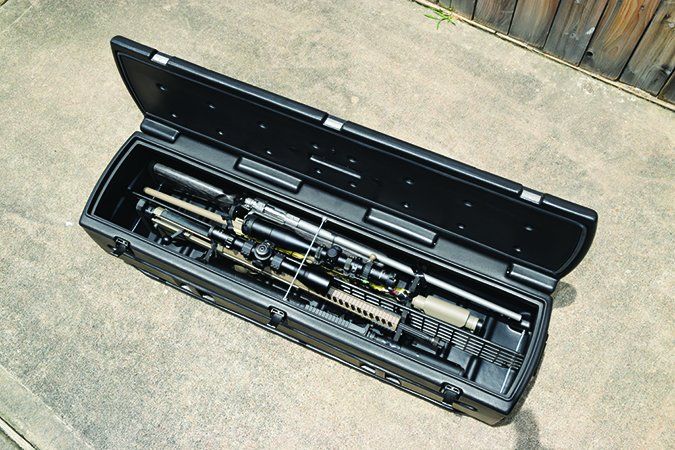
Transporting the Rifles
Du-Ha Upgrades Its Tote
If you’ve ever wondered how I organize multiple rifles for testing, the answer is the $380 Du-Ha Tote from Du-Ha.com. The Tote is an all-in-one storage, toolbox, and gun case that measures 53 inches long, 15 inches wide, and 15 inches tall. The Tote can be configured to carry up to four rifles upright in padded racks. Usually I pack two rifles inside the Tote, leaving plenty of room for an Oehler chronograph and stands, bench bags, eye and ear protection, ammunition, and targets.
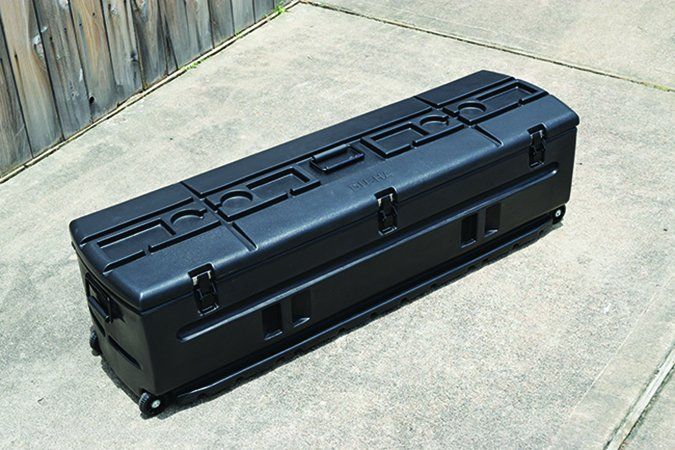
Recently, I used the newest version of the Tote to transport a complete four-gun roster, including a 48-inch-long Ruger Hawkeye and the shorter but bulkier Desert Tech SRS-A1 rifles. The Tote offers the same compartmentalized approach as filling a container like those seen on transport ships. The Tote is on wheels and can be pulled easily in and out of a truck bed, making quick work of changing from one test roster to another. An $80 Slide Bracket that locks the Tote onto its own set of tracks is also available.
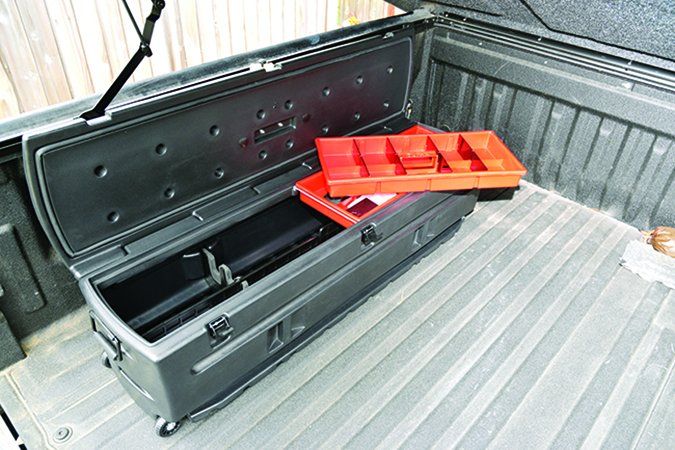
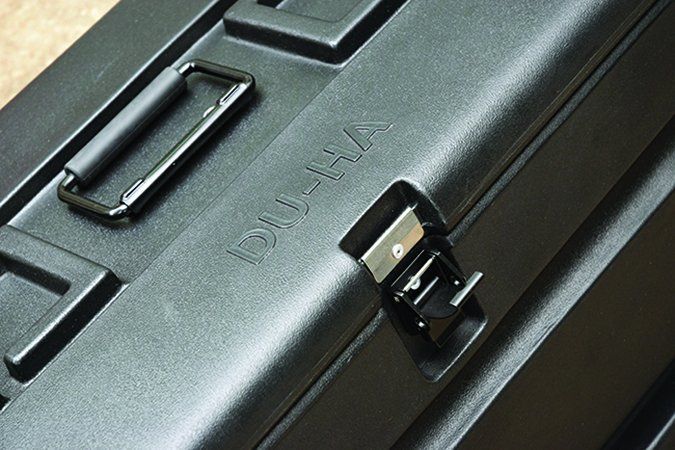
I’ve been using Du-Ha Totes for about three years without fail and recently purchased the latest model, which featured some very appealing upgrades. All exterior handles (top and sides) are now spring loaded to keep them folded and out of harm’s way. Once emptied, the 38-pound Tote is light enough to be picked up like a suitcase. The three exterior latches now seat against steel inserts instead of the rugged polyethylene body. The main hinge has been strengthened, and there’s a potent detent to keep the lid open when desired. The new center brace is hinged, making it easier to insert and remove items. The orange-color tool trays can be configured to suit the shooter’s needs, and the main box offers removable dividers for more secure storage. If going to the range means cluttering your truck bed with stuff, the new Du-Ha Tote provides an even better way of organizing and securing your guns and gear than the original.
Written and photographed by Roger Eckstine, using evaluations from Gun Tests team testers.

























